Your garage door works hard—probably harder than you realize—opening and closing thousands of times every year. When it stops working, you’re left scratching your head, wondering what broke and how much it’ll cost to fix.
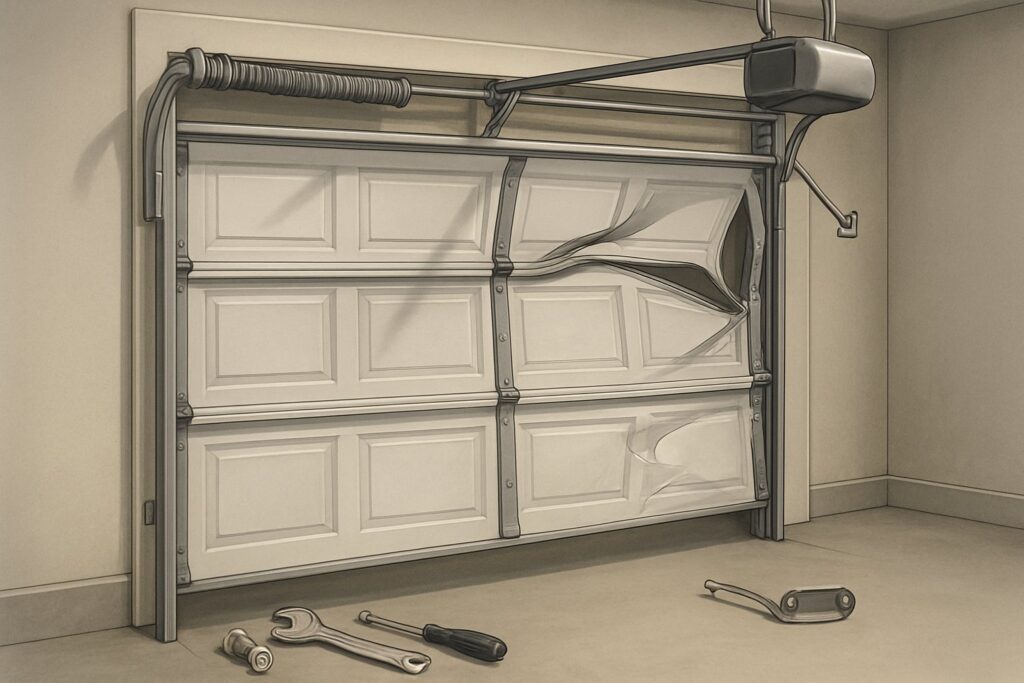
Most garage door repairs run between $98 and $860. Broken springs, cables, openers, and tracks top the list of common headaches for homeowners.
The silver lining? You usually don’t need to replace the whole door. Swapping out a spring or cable often gets things moving again for less than you’d expect.
Knowing what can go wrong and what it’ll cost helps you make better choices when your garage door acts up. Here, you’ll find the most common issues, what causes them, and real repair costs. You’ll also pick up tips to spot problems early and dodge big repair bills.
Need a Home Fix – Emergency or Routine?
From leaks and no-heat nights to simple tune-ups, our 24/7 hotline connects you with trusted local pros in minutes.
Key Takeaways
- Broken springs, faulty openers, damaged cables, and doors that refuse to budge are the usual suspects
- Repairs usually cost $98 to $860, with spring replacement being both the most common and priciest
- Stay ahead with regular maintenance and early fixes—small problems can snowball into expensive repairs
Understanding Common Garage Door Issues
Garage door problems can be as simple as a dead remote battery, or as complicated as a busted spring or mangled track. Most of the time, worn-out parts, misaligned hardware, or just plain old wear and tear are to blame.
Signs of Typical Garage Door Problems
Your garage door usually warns you before it quits. Weird noises—grinding, squeaking, or loud banging—often mean rollers are worn, hardware’s loose, or a spring’s in trouble.
Movement issues are another clue. If your door opens crooked, stops halfway, or reverses for no reason, you might have a track alignment or sensor problem.
Common warning signs include:
- Door feels way too heavy when you lift it by hand
- Spring coils have gaps or cables look frayed
- Door tilts to one side as it moves
- Remote works only sometimes (or not at all)
- Strange grinding or clicking sounds
Physical damage—dented panels, bent tracks, or wobbly hardware—usually gets worse if you ignore it. Don’t wait too long to deal with it.
How Garage Doors Work
Your garage door runs on a system of springs, cables, tracks, and rollers. Springs do most of the heavy lifting, balancing the door’s weight—which can be 150 to 300 pounds.
The opener motor doesn’t actually lift the door by itself. It teams up with the springs to move the door along the tracks.
You’ll find two main kinds of springs: torsion springs (above the door) and extension springs (along the sides). Torsion springs are pretty common and last about 10,000 to 15,000 cycles.
Steel cables attach to the bottom of the door and work with the springs. If a spring snaps, these cables keep the door from crashing down.
Role of Garage Door Components
Every part in your garage door system matters. Springs store and release energy, lifting a door that might weigh 200 to 400 pounds.
Tracks and rollers keep the door moving smoothly. If tracks bend or rollers wear out, you’ll notice jerky, uneven motion—or worse, a stuck door.
Cables help share the load and act as a safety net if a spring fails. Frayed or stretched cables can make your door dangerous to use.
The opener system—motor, drive, and safety sensors—handles the automation. Newer openers reverse the door if they sense something in the way.
Even little things like weather seals, hinges, and mounting brackets play a role. Loose hardware can throw everything out of alignment over time.
Garage Door Won’t Open or Close
If your garage door won’t open or close, your day just got a lot more complicated. You might find your car stuck inside, or maybe you can’t close up for the night.
Most of the time, power issues, remote problems, or busted springs and cables are to blame.
Frequent Causes of Operation Failure
Broken springs are the big one. Springs lift the door’s weight and usually last about 10,000 cycles before they give out.
When a spring snaps, you’ll probably hear a loud bang. The door suddenly feels almost impossible to open by hand.
Logic board failures in the opener can make the door act up. The logic board is kind of like your opener’s brain.
If it fails, remotes and wall buttons might stop working—or work only sometimes.
Damaged cables are another culprit. These steel cables help the door travel safely up and down.
If a cable frays or breaks, the door can tilt or even drop unexpectedly.
Bent tracks can block the door’s path. The rollers need straight, solid tracks to move correctly.
If something hits the tracks or the mounting comes loose, you’ll have problems.
Troubleshooting Power and Remote Issues
First, check if your garage door opener has power. Look for a green light on the motor unit.
No light? Check the breaker or unplug the opener for about 30 seconds and plug it back in.
Test your remote batteries next. Weak batteries can cause all sorts of weird issues.
Swap them out and try using the remote from different spots.
Don’t forget to clean the photo eye sensors near the floor. Even a little dirt or a spider web can block them.
Those sensors need a clear line of sight to work.
Try the wall button inside your garage. If it works but the remote doesn’t, you’ve got a remote issue.
If neither works, you’re probably looking at a power or opener problem.
When to Call a Professional
If you think a spring broke, call a garage door tech right away. Springs are under a ton of tension and can be dangerous.
Trying to fix springs yourself isn’t worth the risk.
Let a pro handle opener motor repairs too. Those motors have electrical parts that need special know-how.
Techs have the right tools and training to do repairs safely.
If your door’s come off its tracks, don’t try to fix it yourself. An off-track door can fall and hurt someone—or wreck your stuff.
Emergency repairs cost more, especially on weekends or at night. Sometimes, though, you just need your car out now.
Most garage door issues need a pro’s eye to find the real problem and keep it from happening again.
Noisy or Unstable Garage Door
If your garage door’s making a racket, you’re probably dealing with worn-out parts, dry rollers, or loose bolts. The good news? Most noise fixes are cheap and easy—usually under $50—though some jobs should be left to the pros.
Identifying Noisy Garage Door Causes
Different noises mean different problems. Squeaking or screeching usually means your parts need some grease.
Grinding happens when metal rubs on metal—often tracks, rollers, or hinges running dry.
Rattling points to loose bolts or brackets. Check all those connection points on the door and tracks.
Banging or popping is a bad sign—springs or cables may be failing. If you hear this, stop using the door and call a pro.
Rumbling from the opener could mean worn gears or a tired motor. Chain drives are always a bit louder than belt drives, but excessive noise isn’t normal.
Try listening as the door runs and move closer to different parts. You’ll usually hear where the noise is coming from.
Common Fixes for Unusual Sounds
Start by lubricating any moving parts. Use white lithium grease on rollers, hinges, and tracks every few months.
Spray garage door lubricant on the springs, but keep the tracks dry—grease there just attracts grime.
Tighten loose hardware with a wrench or screwdriver. Don’t forget bolts and screws on the door panels, tracks, and opener bracket.
If rollers are cracked or don’t roll right, swap them out. Nylon rollers cost a few bucks each and run quieter than steel ones.
| Fix Type | Cost Range | Difficulty |
|---|---|---|
| Lubrication | $5-15 | Easy |
| Tighten hardware | $0 | Easy |
| Replace rollers | $20-60 | Medium |
| Professional spring repair | $150-300 | Hard |
For track alignment, gently tap the tracks with a rubber mallet. Make sure they’re straight and level.
Preventive Maintenance for Noise
Check your garage door setup every few months. Look for worn parts, loose bolts, and anything that looks off before it turns noisy.
Lubricate moving parts regularly. Pay extra attention to rollers, hinges, springs, and the opener drive.
Clean tracks with a damp cloth—no harsh cleaners needed. Dirt and debris can cause a lot of noise.
Test the balance by disconnecting the opener and lifting the door halfway. If it stays put, you’re good. If it moves, you might have a spring issue.
Replace worn parts early. Rollers last 7-10 years, springs 10,000-20,000 cycles—don’t wait for a breakdown.
If your garage sees a lot of use, book a professional tune-up once a year. A tech can catch stuff you might miss.
Keep a few spare bolts and brackets handy. Vibration tends to shake things loose over time.
Spring and Cable Problems
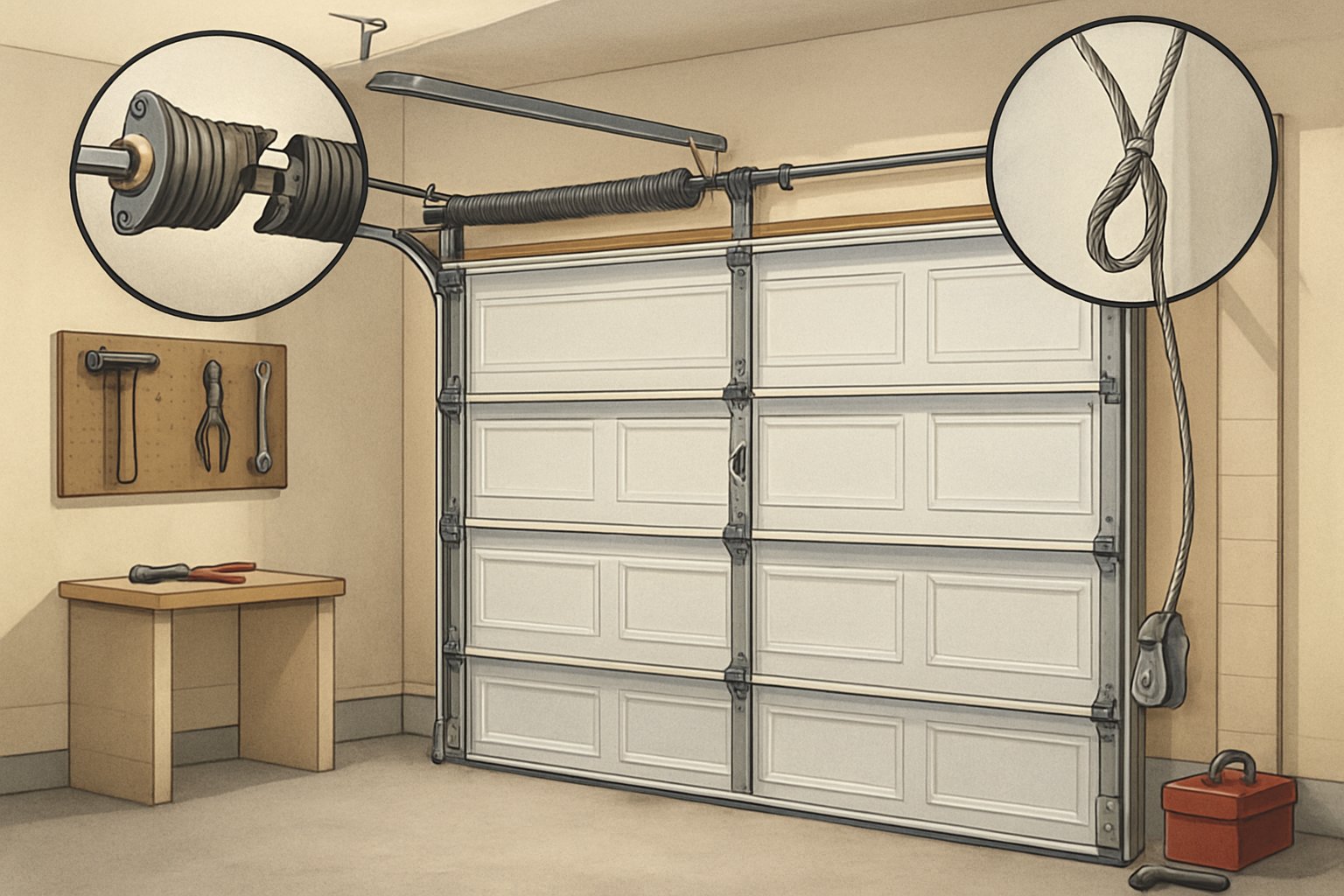
Garage door springs and cables work as a team to lift hundreds of pounds safely. Springs store energy to balance the door’s weight, while cables guide the movement and help prevent disaster if something snaps.
Types of Garage Door Springs
Most garage doors use one of two spring systems. Each type brings its own costs and installation quirks.
Torsion springs sit above your garage door opening and twist to store energy. Replacing one usually runs $5-$200, and most homes have one or two depending on the door size.
These springs handle 200-400 pounds of stored energy. They usually last 7-12 years or about 10,000-15,000 cycles before giving out.
Extension springs stretch along the sides of the door. They’re cheaper than torsion springs but need safety cables, and you have to replace both if one breaks.
Professional garage door repair averages about $300 for spring replacement, labor included. The price depends on your door’s size and the spring type.
Symptoms of Broken Springs or Cables
Broken springs or cables throw out some pretty clear warning signs. Catching these early can stop bigger headaches down the road.
Spring failure signs include:
- Loud snapping or popping noises
- Door feels way too heavy to lift by hand
- Visible gaps in the spring coils
- Door opens crooked or uneven
- Opener strains or just quits working
Cable problems show these symptoms:
- Frayed or kinked cable strands
- Door tilts to one side while moving
- Loose or slack cables hanging down
- Grinding noises near the cables
- Door suddenly drops or falls too fast
A garage door tech can check these parts during regular maintenance. Spotting problems early usually saves you a bundle.
Risks of DIY Repairs
Spring and cable repairs aren’t just tricky—they’re genuinely dangerous. Professional garage door repair keeps you safe from some nasty injuries.
Garage door springs store a scary amount of tension. Torsion springs alone pack 200-400 pounds of force, and messing up can mean serious injury or worse.
DIY repair dangers include:
- Spring tension causing cuts or broken bones
- Heavy doors falling and smashing fingers
- Improper installation leading to breakdowns later
- Voiding warranties on your garage door parts
Pros have special tools and know-how. They get spring tension right and follow safety steps that protect everyone at home.
Most companies charge $98-$400 for cable work, labor included. That’s nothing compared to what a hospital bill might look like after a DIY mishap.
Issues With Garage Door Openers
Opener problems can leave your garage door stuck or acting up. Most issues hit the opener motor, safety sensors, or remotes, and fixing them usually costs $100-$600.
Common Opener Malfunctions
Motor problems top the list for expensive fixes. Sometimes the motor grinds, runs without moving the door, or just dies.
If the opener reverses while closing, first check for stuff blocking the door. Dirty or misaligned safety sensors are often to blame.
Travel limit settings tell the door how far to move. If the door stops halfway or reverses, you might need to tweak the screws on the motor unit. It’s not rocket science, but it’s easy to overlook.
Force settings control the opener’s muscle. If the door struggles to open, the force might be too low. If it slams, it’s probably too high.
The RPM sensor keeps tabs on motor speed. If it fails, the door might stop for no reason. Swapping the sensor usually costs $50-$80.
Power supply issues are usually a quick fix. Make sure the opener’s plugged in and check the circuit breaker.
Sensor and Remote Failures
Safety sensors keep the door from closing if something’s in the way. They sit on both sides of the opening, about 6 inches up from the floor.
Dirty lenses cause most sensor headaches. Wipe them with a soft cloth and a little cleaner.
Misaligned sensors won’t face each other right. Loosen the mounting screws and adjust until both lights stay solid. If they blink, keep fiddling.
Damaged sensor wires break the connection to the opener. Look for cuts, pinches, or loose spots along the wire.
Remote control problems usually mean dead batteries or lost programming. Swap the batteries first, then reprogram using your opener manual if needed.
If all your remotes quit, the opener’s receiver board probably died. Replacing it costs $80-$150.
Cost to Repair or Replace Garage Door Openers
Basic repairs run $100-$300 for most opener issues. That covers sensor tweaks, remote programming, and simple part swaps.
Motor replacement costs $200-$400, including labor. The circuit board, drive gear, and capacitor are common troublemakers.
Complete opener replacement lands between $300-$600 installed. Chain drive openers are the budget option, while belt or direct drive models cost more.
| Repair Type | Cost Range |
|---|---|
| Sensor alignment | $75-$150 |
| Remote programming | $50-$100 |
| Circuit board | $150-$250 |
| Motor replacement | $200-$400 |
| New opener install | $300-$600 |
Labor costs usually fall between $75-$125 per hour. Simple fixes take half an hour or so, but bigger jobs can eat up 2-3 hours.
Age matters—if your opener is over 15 years old, replacement usually makes more sense than another repair.
Cost Breakdown for Common Garage Door Repairs
Garage door repair costs usually fall between $98 and $860. Most folks pay $150 to $350 for the everyday stuff. Spring swaps, opener fixes, and cable repairs make up most calls, but emergencies can double your bill.
Average Price Ranges by Repair Type
Basic repairs cost $98 to $300 and cover single issues like springs, cables, or rollers.
Mid-range repairs run $245 to $300 when you need a few things done at once.
Complex repairs jump to $300-$860 for big jobs like opener or panel replacements.
| Repair Type | Cost Range | What’s Included |
|---|---|---|
| Spring replacement | $180-$350 | Torsion or extension springs plus labor |
| Cable repair | $98-$400 | Steel cables and tension adjustment |
| Opener replacement | $200-$700 | New motor unit with installation |
| Panel replacement | $400-$860 | Single panel with fitting work |
| Track realignment | $147-$400 | Bent track repair or replacement |
Diagnostic visits cost $50 to $75. Most contractors drop this fee if you go ahead with the repair.
Labor and Emergency Repair Costs
Certified garage door techs charge about $63 an hour on average. In big cities, rates can hit $150 or more.
Most pros give you a flat price per project instead of charging by the hour. That way, you know what you’re in for upfront.
Emergency repairs cost a lot more than scheduled visits. A $300 spring swap can shoot up to $600 for after-hours or weekend calls.
Where you live matters—a lot. Cities like San Francisco or New York cost way more than small towns in the Midwest.
Specialists charge more than general handymen, but they know how to handle spring tension and safety rules. That peace of mind is worth something.
Factors That Affect Pricing
Door size changes the price since big doors need bigger, pricier parts. Double-car doors always cost more to fix.
Door type also plays a role. Sectional doors are cheapest to repair because parts are everywhere. Roll-up doors? Expect to pay 20-30% more since the parts are specialized.
Material quality matters too. Higher-end springs, cables, and hardware can bump your bill up by 25-50%.
Age and availability of parts can make things tricky. Old or custom doors might need special-ordered parts, which means waiting 2 to 6 weeks and paying double.
Multiple repairs in one visit can save you cash compared to spreading them out.
DIY vs Professional Garage Door Repair
DIY repairs are fine for easy stuff like reprogramming remotes or swapping weatherstripping. Usually, you’ll spend under $100 on parts.
Professional repair is a must for springs, cables, and openers. Springs store 200-400 pounds of tension, and you need the right tools and know-how.
Safety risks make pro service the smart move for most repairs. Mess up a spring install and you could get hurt or damage your house.
Warranty protection comes with professional work, but not with DIY. Most techs guarantee their repairs for 6 months to a year.
Tool costs for pro-grade repairs can run more than just hiring someone. Spring winding bars and tension tools aren’t cheap.
Maximizing Garage Door Lifespan and Preventing Future Issues
Regular maintenance and smart repair choices can stretch your garage door’s life from 15 years to 30 or more. Picking the right tech and knowing when to repair or replace saves money—and headaches.
Routine Maintenance Tips
Clean your garage door tracks every three months to clear out dirt and gunk. If you let grime build up, rollers work harder and wear out faster.
Lubricate moving parts twice a year with white lithium grease or a garage door spray. Hit the hinges, rollers, springs, and the chain or belt drive.
- Hinges
- Rollers
- Springs
- Chain or belt drive
Test the door’s balance once a month. Disconnect the opener and lift the door halfway—if it stays put, you’re good. If it moves, call a tech.
Check the weather stripping around the frame. Replace any cracked or torn seals to keep out moisture and critters.
Listen for weird noises like grinding or squealing. Catching these early can save you from bigger repairs later.
Test the safety features monthly. Put a roll of paper towels under the door when closing. It should reverse right away if everything works.
When to Replace vs Repair a Garage Door
Replace your garage door if it’s more than 20 years old and keeps breaking down. If you’re calling for repairs every few months, replacement probably costs less in the long run.
Major damage—like bent panels, cracked frames, or rusted-out sections—means it’s time for a new door. Big safety problems with springs or cables also call for replacement.
Repair makes sense for single part failures on doors under 15 years old. Fixes like:
- Broken springs (just one side)
- Worn rollers
- Bad openers
- Damaged weather stripping
Weigh repair costs against the price of a new door. If repairs hit 50% or more of what a new door costs, just replace it.
Thinking about upgrades? Insulated doors cut energy bills and run quieter than old single-layer doors. Worth considering if you’re already making changes.
Choosing a Qualified Garage Door Technician
Always check for licensing and insurance when you’re hiring a garage door technician. Licensed pros carry liability insurance, which keeps your property protected during repairs.
Take a look at online reviews and ask for references from people nearby. Good technicians offer written estimates and actually walk you through your repair choices.
Ask about warranties for both parts and labor. The better companies usually back repairs for at least a year, and major components come with even longer coverage.
For bigger jobs, get a few quotes before deciding. The price should cover labor, materials, and hauling away the old stuff—otherwise, you’ll end up with surprise fees.
Pick technicians who show up with common parts stocked in their trucks. It’s just less hassle and usually means your garage door gets fixed the same day.
Honestly, steer clear of door-to-door solicitors or any offer that seems too cheap. Quality repairs need proper tools, training, and real parts, which aren’t free.
Frequently Asked Questions
Garage door repair costs depend on a handful of things—where you live, what’s broken, and local labor rates. For example, spring replacements usually run about $300. Bent track repairs can range from $147 up to $400, depending on how bad the damage is.
What factors influence the cost of repairing a garage door?
Your location makes a huge difference in price. Cities like San Francisco or New York? Expect to pay more than folks in rural areas for the same repair.
The damage type matters, too. Fixing a single broken spring costs less than replacing a bunch of parts. If you need emergency repairs, the bill jumps up fast.
Labor rates depend on the technician’s experience. Certified garage door techs usually charge around $63 an hour, but some seasoned pros go as high as $150 per hour.
Don’t forget your door’s age and size. Older doors use parts that are harder to find and pricier. Double-car doors need bigger, more expensive components than single-car ones.
How much does it typically cost to replace a broken garage door spring?
Replacing a torsion spring typically costs about $300 for parts and labor. The springs themselves range from $5 to $200 each, depending on what you need.
Extension spring repairs are in the same ballpark. You’ll have to replace both springs and add safety cables, so the total ends up close to torsion spring pricing.
Don’t try spring repairs yourself. Those springs store 200 to 400 pounds of tension—seriously dangerous. Let a pro with the right tools and know-how handle it.
Can the price of fixing a bent garage door vary, and what are the typical costs?
Simple off-track fixes cost about $147. If you need the whole track replaced, costs can go up to $400, depending on how bad things are.
Track sections themselves usually run $40 to $120 each. Most of what you pay is for the labor. If you call for emergency off-track repair, expect to pay a few hundred bucks extra.
Vehicles hitting the track or foundation settling cause most of these problems. Side impacts bend vertical tracks, while loose mounts or settling shift the horizontal ones.
What is the range of prices for professional garage door repair services?
Basic repairs for a single part—like springs, rollers, or cables—cost $98 to $300. Mid-level repairs involving more than one part usually land between $245 and $300.
Complex jobs can run from $300 up to $860. That covers major part replacements or fixing the opener. Full system overhauls might cost anywhere from $371 to $1,231.
Diagnostic visits typically cost $50 to $75. Most contractors knock that fee off your final bill if you hire them. They’ll usually bundle diagnosis, parts, and labor into the project price.
What should I expect to pay for repairing or replacing garage door wiring?
Opener repairs really depend on what’s wrong. Something simple like remote programming costs $20 to $300. Swapping out the motor runs $180 to $400.
Circuit board issues or sensor problems need a pro to figure out. Worn brushes and busted gears are common electrical culprits. Sometimes, even LED lights can mess with your remote signal.
Honestly, replacing the whole opener is sometimes cheaper than fixing a big electrical problem. Chain-drive openers cost $200 to $300 installed, while belt-drive models are more—expect $600 to $700.
How does accidental damage, such as backing into a garage door, affect repair costs?
When a car hits a garage door, it usually messes up the panels and bends the tracks. If you need to swap out a single aluminum panel, expect to pay around $400.
If you end up with several damaged panels, honestly, replacing the whole door might make more sense financially.
Impacts can also twist tracks or snap hardware. Swapping out a track runs anywhere from $40 up to $400 for each section, depending on how heavy your door is.
If your car’s stuck inside and you need someone out fast, emergency repairs can tack on a few hundred bucks.
Depending on your insurance policy, you might get some help covering accidental damage. Take photos of everything before calling for repairs.
And really, don’t settle for the first price—get a few quotes so you know you’re not getting ripped off.
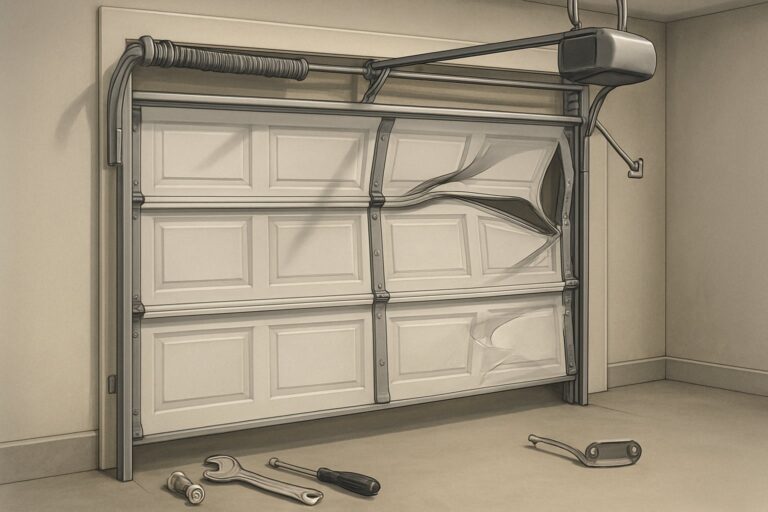

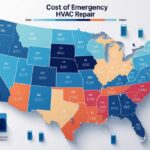


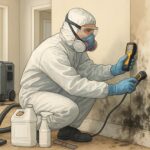

Leave a Reply